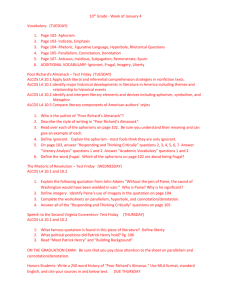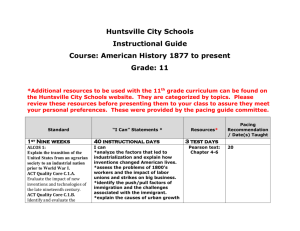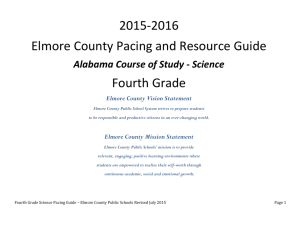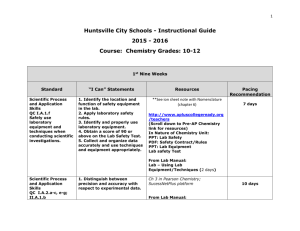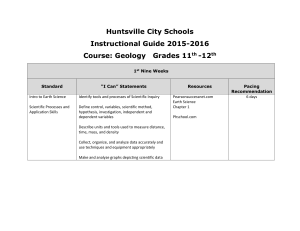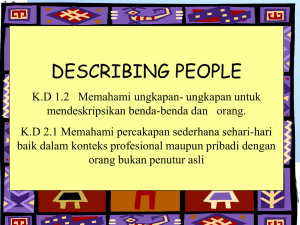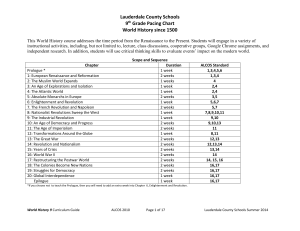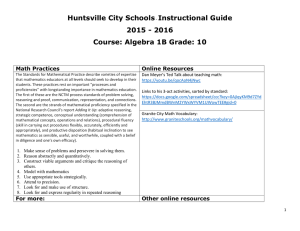11th Grade U.S. History: Curriculum Pacing Guide Unit Standard
advertisement
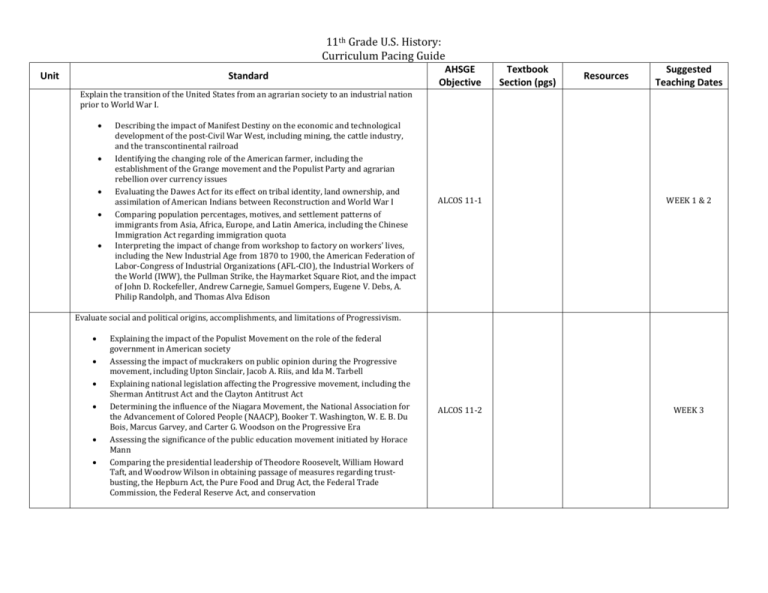
11th Grade U.S. History: Curriculum Pacing Guide Unit Standard AHSGE Objective Textbook Section (pgs) Resources Suggested Teaching Dates Explain the transition of the United States from an agrarian society to an industrial nation prior to World War I. Describing the impact of Manifest Destiny on the economic and technological development of the post-Civil War West, including mining, the cattle industry, and the transcontinental railroad Identifying the changing role of the American farmer, including the establishment of the Grange movement and the Populist Party and agrarian rebellion over currency issues Evaluating the Dawes Act for its effect on tribal identity, land ownership, and assimilation of American Indians between Reconstruction and World War I Comparing population percentages, motives, and settlement patterns of immigrants from Asia, Africa, Europe, and Latin America, including the Chinese Immigration Act regarding immigration quota Interpreting the impact of change from workshop to factory on workers’ lives, including the New Industrial Age from 1870 to 1900, the American Federation of Labor-Congress of Industrial Organizations (AFL-CIO), the Industrial Workers of the World (IWW), the Pullman Strike, the Haymarket Square Riot, and the impact of John D. Rockefeller, Andrew Carnegie, Samuel Gompers, Eugene V. Debs, A. Philip Randolph, and Thomas Alva Edison ALCOS 11-1 WEEK 1 & 2 ALCOS 11-2 WEEK 3 Evaluate social and political origins, accomplishments, and limitations of Progressivism. Explaining the impact of the Populist Movement on the role of the federal government in American society Assessing the impact of muckrakers on public opinion during the Progressive movement, including Upton Sinclair, Jacob A. Riis, and Ida M. Tarbell Explaining national legislation affecting the Progressive movement, including the Sherman Antitrust Act and the Clayton Antitrust Act Determining the influence of the Niagara Movement, the National Association for the Advancement of Colored People (NAACP), Booker T. Washington, W. E. B. Du Bois, Marcus Garvey, and Carter G. Woodson on the Progressive Era Assessing the significance of the public education movement initiated by Horace Mann Comparing the presidential leadership of Theodore Roosevelt, William Howard Taft, and Woodrow Wilson in obtaining passage of measures regarding trustbusting, the Hepburn Act, the Pure Food and Drug Act, the Federal Trade Commission, the Federal Reserve Act, and conservation 11th Grade U.S. History: Curriculum Pacing Guide Unit Standard AHSGE Objective Textbook Section (pgs) Resources Suggested Teaching Dates Explain the United States’ changing role in the early twentieth century as a world power. Describing causes of the Spanish-American War, including yellow journalism, the sinking of the Battleship USS Maine, and economic interests in Cuba Identifying the role of the Rough Riders on the iconic status of President Theodore Roosevelt Describing consequences of the Spanish-American War, including the Treaty of Paris of 1898, insurgency in the Philippines, and territorial expansion in the Pacific and Caribbean Analyzing the involvement of the United States in the Hawaiian Islands for economic and imperialistic interests Appraising Alabama’s contributions to the United States between Reconstruction and World War I, including those of William Crawford Gorgas, Joseph Wheeler, and John Tyler Morgan Evaluating the role of the Open Door policy and the Roosevelt Corollary on America’s expanding economic and geographic interests Comparing the executive leadership represented by William Howard Taft’s Dollar Diplomacy, Theodore Roosevelt’s Big Stick Diplomacy, and Woodrow Wilson’s Moral Diplomacy ALCOS 11-3 WEEK 4 ALCOS 11-4 WEEK 5 & 6 Describe causes, events, and the impact of military involvement of the United States in World War I, including mobilization and economic and political changes. Identifying the role of militarism, alliances, imperialism, and nationalism in World War I Explaining controversies over the Treaty of Versailles of 1919, Woodrow Wilson’s Fourteen Points, and the League of Nations Explaining how the Treaty of Versailles led to worsening economic and political conditions in Europe, which provided opportunities for the rise of fascist states in Germany, Italy, and Spain Comparing short and long-term effects of changing boundaries in pre- and postWorld War I in Europe and the Middle East, leading to the creation of new countries 11th Grade U.S. History: Curriculum Pacing Guide Unit Standard AHSGE Objective Textbook Section (pgs) Resources Suggested Teaching Dates Evaluate the impact of social changes and the influence of key figures in the United States from World War I through the 1920s, including Prohibition, the passage of the Nineteenth Amendment, the Scopes Trial, limits on immigration, Ku Klux Klan activities, the Red Scare, Susan B. Anthony, Margaret Sanger, Elizabeth Cady Stanton, the Harlem Renaissance, the Great Migration, W. C. Handy, the Jazz Age, and Zelda Fitzgerald. Analyzing radio, movies, newspapers, and popular magazines for their impact on the creation of mass culture Analyzing works of major American artists and writers, including F. Scott Fitzgerald, Ernest Hemingway, Langston Hughes, and H. L. Mencken, to characterize the era of the 1920s Determining the relationship between technological innovations and the creation of increased leisure time ALCOS 11-5 WEEK 7 ALCOS 11-6 WEEK 8 ALCOS 11-7 WEEK 9 Describe social and economic conditions from the 1920s through the Great Depression regarding factors leading to a deepening crisis, including the collapse of the farming economy and the stock market crash of 1929. Assessing effects of overproduction, stock market speculation, and restrictive monetary policies on the pending economic crisis Describing the impact of the Smoot-Hawley Tariff Act on the global economy and the resulting worldwide depression Identifying notable authors of the 1920s, including John Steinbeck, William Faulkner, and Zora Neale Hurston Analyzing the Great Depression for its impact on the American family Explain strengths and weaknesses of the New Deal in managing problems of the Great Depression through relief, recovery, and reform programs, including the Tennessee Valley Authority (TVA), the Works Progress Administration (WPA), the Civilian Conservation Corps (CCC), and the Social Security Act. Analyzing conditions created by the Dust Bowl for their impact on migration patterns during the Great Depression 11th Grade U.S. History: Curriculum Pacing Guide Unit Standard AHSGE Objective Textbook Section (pgs) Suggested Resources Suggested Teaching Date Summarize events leading to World War II, including the militarization of the Rhineland, Germany’s seizure of Austria and Czechoslovakia, Japan’s invasion of China, and the Rape of Nanjing. Analyzing the impact of fascism, Nazism, and communism on growing conflicts in Europe Explaining the isolationist debate as it evolved from the 1920s to the bombing of Pearl Harbor and the subsequent change in United States’ foreign policy Identifying roles of significant World War II leaders Examples: Franklin D. Roosevelt, Harry S. Truman, Dwight D. Eisenhower, George S. Patton, Sir Winston Churchill, Bernard Montgomery, Joseph Stalin, Benito Mussolini, Emperor Hirohito, Hedeki Tōjō, Erwin Rommel, Adolf Hitler Evaluating the impact of the Munich Pact and the failed British policy of appeasement resulting in the invasion of Poland ALCOS 11-8 WEEK 10 ALCOS 11-9 WEEK 11 ALCOS 11-10 WEEK 12 Describe the significance of major battles, events, and consequences of World War II campaigns, including North Africa, Midway, Normandy, Okinawa, the Battle of the Bulge, Iwo Jima, and Yalta and Potsdam Conferences. Locating on a map or globe the major battles of World War II and the extent of the Allied and Axis territorial expansion Describing military strategies of World War II, including blitzkrieg, island-hopping, and amphibious landings Explaining reasons for and results of dropping atomic bombs on Japan Explaining events and consequences of war crimes committed during World War II, including the Holocaust, the Bataan Death March, the Nuremberg Trials, the post-war Universal Declaration of Human Rights, and the Genocide Convention Describe the impact of World War II on the lives of American citizens, including wartime economic measures, population shifts, growth in the middle class, growth of industrialization, advancements in science and technology, increased wealth in the African American community, racial and ethnic tensions, the G. I. Bill of Rights of 1944, and desegregation of the military. Describing Alabama’s participation in World War II, including the role of the Tuskegee Airmen, the Aliceville Prisoner of War (POW) camp, growth of the Port of Mobile, production of Birmingham steel, and the establishment of military bases 11th Grade U.S. History: Curriculum Pacing Guide Unit Standard AHSGE Objective Textbook Section (pgs) Suggested Resources Suggested Teaching Date Describe the international role of the United States from 1945 through 1960 relative to the Truman Doctrine, the Marshall Plan, the Berlin Blockade, and the North Atlantic Treaty Organization (NATO). Describing Cold War policies and issues, the domino theory, McCarthyism, and their consequences, including the institution of loyalty oaths under Harry S. Truman, the Alger Hiss case, the House Un-American Activities Committee, and the execution of Julius and Ethel Rosenberg Locating areas of conflict during the Cold War from 1945 to 1960, including East and West Germany, Hungary, Poland, Cuba, Korea, and China ALCOS 11-11 WEEK 13 ALCOS 11-12 WEEK 13 ALCOS 11-13 WEEK 14 Describe major initiatives of the John F. Kennedy and Lyndon B. Johnson Administrations. Describing Alabama’s role in the space program under the New Frontier Describing major foreign events and issues of the John F. Kennedy Administration, including construction of the Berlin Wall, the Bay of Pigs invasion, and the Cuban missile crisis Trace the course of the involvement of the United States in Vietnam from the 1950s to 1975, including the Battle of Dien Bien Phu, the Gulf of Tonkin Resolution, the Tet Offensive, destabilization of Laos, secret bombings of Cambodia, and the fall of Saigon. Locating on a map or globe the divisions of Vietnam, the Ho Chi Minh Trail, and major battle sites Describing the creation of North and South Vietnam 11th Grade U.S. History: Curriculum Pacing Guide Unit Standard AHSGE Objective Textbook Section (pgs) Suggested Resources Suggested Teaching Date Trace events of the modern Civil Rights Movement from post-World War II to 1970 that resulted in social and economic changes, including the Montgomery Bus Boycott, the desegregation of Little Rock Central High School, the March on Washington, Freedom Rides, the Sixteenth Street Baptist Church bombing, and the Selma-to-Montgomery March. Tracing the federal government’s involvement in the modern Civil Rights Movement, including the abolition of the poll tax, the nationalization of state militias, Brown versus Board of Education in 1954, the Civil Rights Acts of 1957 and 1964, and the Voting Rights Act of 1965 Explaining contributions of individuals and groups to the modern Civil Rights Movement, including Martin Luther King, Jr., James Meredith, Medgar Evers, Thurgood Marshall, the Southern Christian Leadership Conference (SCLC), the Student Nonviolent Coordinating Committee (SNCC), the Congress of Racial Equality (CORE), the National Association for the Advancement of Colored People (NAACP), and the civil rights foot soldiers Appraising contributions of persons and events in Alabama that influenced the modern Civil Rights Movement, including Rosa Parks, Autherine Lucy, John Patterson, George C. Wallace, Vivian Malone Jones, Fred Shuttlesworth, the Children’s March, and key local persons and events Describing the development of a Black Power movement, including the change in focus of the SNCC, the rise of Malcolm X, and Stokely Carmichael and the Black Panther movement Describing the economic impact of African-American entrepreneurs on the modern Civil Rights Movement, including S. B. Fuller and A. G. Gaston Describe changing social and cultural conditions in the United States during the 1950s, 1960s, and 1970s. ALCOS 11-14 WEEK 15 & 16 ALCOS 11-15 WEEK 17 ALCOS 11-16 WEEK 17 Describe significant foreign and domestic issues of presidential administrations from Richard M. Nixon to the present. Examples: Nixon’s policy of détente; Cambodia; Watergate scandal; pardon of Nixon; Iranian hostage situation; Reaganomics; Libyan crisis; end of the Cold War; Persian Gulf War; impeachment trial of William (Bill) Clinton; terrorist attack of September 11, 2001; Operation Iraqi Freedom; war in Afghanistan; election of the first African-American president, Barack Obama
